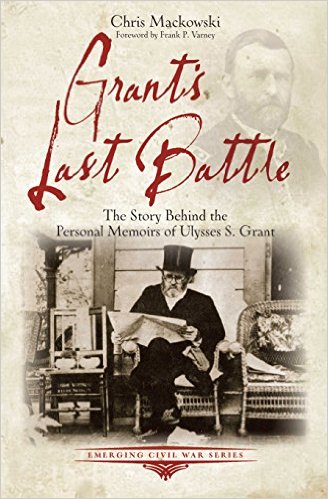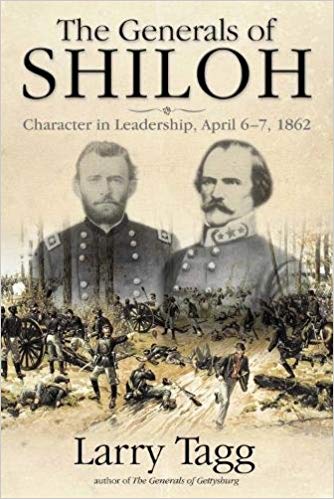Grant’s Last Battle: The Story Behind the Personal Memoirs of Ulysses S. Grant by Chris Mackowski. Savas Beatie, 2015. Paper, ISBN 978-1611211603. $14.95.
 In the decades after the Civil War ended, the full measure of the conflict’s effect on the American people could be measured by the publication of an unprecedented number of autobiographies and memoirs. These accounts offered an array of perspectives on the conflict, but the accounts of military commanders were the most prized. And no account was more highly sought after than that of the general who led the U. S. forces to victory—Ulysses S. Grant.
In the decades after the Civil War ended, the full measure of the conflict’s effect on the American people could be measured by the publication of an unprecedented number of autobiographies and memoirs. These accounts offered an array of perspectives on the conflict, but the accounts of military commanders were the most prized. And no account was more highly sought after than that of the general who led the U. S. forces to victory—Ulysses S. Grant.
For twenty years, Grant resisted offers to pen his account of the war and instead focused his energy on his political career, presidency, and world travels. Many assumed that the three-volume Military History of Ulysses S. Grant, written by Grant’s aide Adam Badeau, was the closest the nation would have to the general’s account of the Civil War. Only after his financial firm collapsed in 1884 and his family faced ruin did Grant decide to undertake writing his memoirs. In the autumn of that year, the diagnosis of throat cancer made the effort to complete the work a race with time. The posthumous publication of The Memoirs of Ulysses S. Grant brought an enormous financial windfall to the family while introducing the nation to the author’s literary skill.
Grant’s ordeal to finish his memoir has already been explored in Thomas Pitkin’s The Captain Departs, Charles Bracelen Flood’s Grant’s Final Victory, and Mark Perry’s Grant and Twain. In Grant’s Last Battle: The Story Behind the Personal Memoirs of Ulysses S. Grant, Chris Mackowski offers the clearest and most vibrant account of Grant’s struggle to complete his memoir. Grant’s Last Battle is an entry in Savas Beatie’s Emerging Civil War series, which is dedicated to publishing original scholarship for a broader audience.
Mackowski, a professor of journalism, has crafted a crisp narrative that captures the urgency of Grant’s struggle to complete his work, and the public spectacle surrounding that struggle. Grant’s own correspondence is effectively utilized in an effort to give the reader an often deeply personal view of Grant’s final year. In spite of Mackowski’s ability to craft such readable language, he occasionally slips into hyperbolic and overwrought passages. For instance, he raises the important episode of Grant’s break with Badeau (after the long-time aide questioned Grant’s authorship), with overwrought phrasing that skews the narrative’s balance. After discussing Mark Twain’s famous comparison of Grant’s memoirs to Caesar’s, Mackowski writes: “Unfortunately, the comparison to Caesar would extend beyond the book. With pen in hand poised as a dagger, Grant’s own Brutus was about to stab him in the back” (76). Sentences such as these mar an otherwise fine narrative by diminishing the author’s ability to dispassionately weigh evidence.
Those clunky, overwrought passages are disappointing because Mackowski does offer perceptive analysis throughout the text. Discussing the question of Grant’s authorship—a question that persists to this day—Mackowski provides a most convincing case of Grant’s ability to write. Mackowski understands the intricacies of the manuscript that proves Grant as author, but he recognizes Grant’s power as a writer. “[T]he great secret of Grant’s writing,” Mackowski writes, can be found in the countless orders written as a military commander. “Grant’s military service had honed his writing to crisp clarity,” he adds (21).
In addition to the incisive narrative, Grant’s Last Battle offers an ample selection of images to attract the general reader. Many of the images are rare and fascinating, particularly those of Grant’s final days at Mt. McGregor. Especially powerful are illustrations of the dying Grant from Frank Leslie’s Illustrated Newspaper (49, 53). Yet, many of the author’s images are not well represented by the black and white reproductions. Photos of P.T. Barnum, the cover of Ben Hur, and even Groucho Marx seem excessive and unnecessary (42, 57, 132).
Several appendices, authored by others, are included to carry out the series’ mission of appealing to a wider audience. Except for an essay on the memorials dedicated to Grant around the world, the appendices are far from compelling. Short essays on Grant’s presidency and the colorful history of Grant’s Tomb make for a disjointed book. While such pieces may refresh the minds of the general reader, I came away thinking that these sections crowded out more of Mackowski’s original story. The inclusion of these essays is even more regrettable since the book’s annotations have been made available only online.
Surprisingly, Mackowski’s conclusion is a pastiche of other scholars’ take on the memoirs. After his interesting narrative, I hoped that I would get more of his perceptive thoughts. The disappointing essays that follow give the book an anti-climactic feel. In sum, the author has clearly achieved the goal of producing an interesting narrative book for general readers. It is well researched and argued, but its limitations may blunt its impact on scholarship. The absence of annotations from the physical book will limit its appeal to scholars.
Aaron Scott Crawford is a Postdoctoral Fellow at the Center for Presidential History at Southern Methodist University in Dallas, and Associate Editor at the Ulysses S. Grant Papers Project, housed at the Ulysses S. Grant Presidential Library at Mississippi State University.




